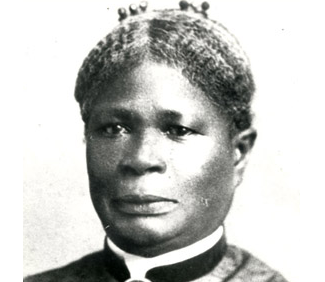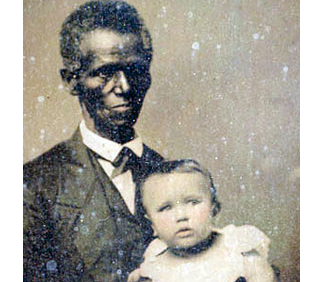

Selina Norris Grey, the daughter of Sally and Leonard Norris, was a part of the second generation of the Custis enslaved population. She was the personal maid to Mary Custis Lee. By the beginning of the Civil War, Selina was the head housekeeper. Although marriages between enslaved people were not legally binding in Virginia, Selina and her husband, Thornton Gray, were married in the parlor of Arlington House by an Episcopal clergyman. The Grays had eight children.
Several years after George Washington Parke Custis’ death in 1857, Selina and her family were freed by the executor of his will, Robert E. Lee in 1862. The family continued to live on the estate for many years. They later settled in Green Valley near Arlington, Virginia.
In 1929 and 1930, Selina’s daughters, Annice Gray Baker and Ada Thompson were interviewed during the restoration of Arlington House by the War Department. They donated several items that Mrs. Lee had given to Selina Gray in the 1860s.

Thornton Gray descended from enslaved people once owned by George and Martha Washington at Mount Vernon. George Washington Parke Custis inherited the 1,100 acre Arlington estate and some of the enslaved population from Mount Vernon in 1802, after the death of his grandmother, Martha Washington.
While enslaved on the Arlington Plantation, Gray, labored as a handyman, stable-hand, and sometimes served as a second carriage driver to the Lee family.
Thornton Gray married Selina Norris on the Arlington plantation. They occupied the west end of the south quarters, located behind the plantation house, now known as Arlington House. The Greys shared their small quarters with their eight children; Emma, Annice, Florence, Sara, Ada, Selina, John and Harry.
After the Civil War, Thornton and his family settled near Arlington in Green Valley. Thornton and his daughters operated a produce business in Washington D.C. for many years.

Born on the Arlington plantation, Maria Carter Syphax was the daughter of George Washington Parke Custis and Arianna Carter, an enslaved woman who was a maid at Mount Vernon.
In 1826, Maria married Charles Syphax. In the same year, Custis emancipated Maria, gave her a 17-acre tract of land, and a cabin on the edge of the plantation. Maria and Charles had ten children, two daughters and eight sons, who all lived as free persons. Some of her children attended schools in Washington, D.C. After the Civil War, several of Maria’s sons successfully petitioned Congress to ensure that their mother retained her property rights. Maria Syphax lived on her property until her death.
Several years after George Washington Parke Custis’ death in 1857, Selina and her family were freed by the executor of his will, Robert E. Lee in 1862. The family continued to live on the estate for many years. They later settled in Green Valley near Arlington, Virginia. In 1929 and 1930, Selina’s daughters, Annice Gray Baker and Ada Thompson were interviewed during the restoration of Arlington House by the War Department. They donated several items that Mrs. Lee had given to Selina Gray in the 1860s.

Charles Syphax was born on the Mount Vernon plantation to an enslaved woman and a free black preacher. Charles came to Arlington with George Washington Parke Custis in 1802. He was the butler and head of the dining room at Arlington House.
Charles was a leader among the Arlington enslaved people., He married Maria Carter around 1826. After their marriage, Maria received her freedom. Charles remained enslaved until 1862. The Syphaxes lived on their own 17-acre plot at Arlington. The couple had 10 children who lived as free persons on the estate. Maria and Charles made most of the household management decisions. Charles' health seriously declined in his final years. The Syphax children attained positions of leadership in the field of education and served as elected officials. Many of their descendants continue tol live in Arlington County.

James Parks was born to Lawrence Parks and Patsy Clark on the Arlington plantation in 1843. He worked in the fields and rarely saw the inside of the plantation house. Although it was illegal to educate enslaved people in Virginia, Parks and other enslaved people, were taught how to read and write in the school conducted by Mrs. Custis. Parks married twice and fathered twenty-two children.
Having witnessed the many phases of the Arlington estate, Parks was critical to preserving a more complete history of life at the property. During the Civil War he helped construct the enclosing wall around the cemetery on the property and assisted with burials.
Parks worked at what later became Arlington National Cemetery as an undertaker until 1925. Several journalists interviewed Parks in his later years and recorded his memories of the old plantation. Parks lived on the Arlington property until his death in 1929. He was buried at Arlington National Cemetery with full military honors.